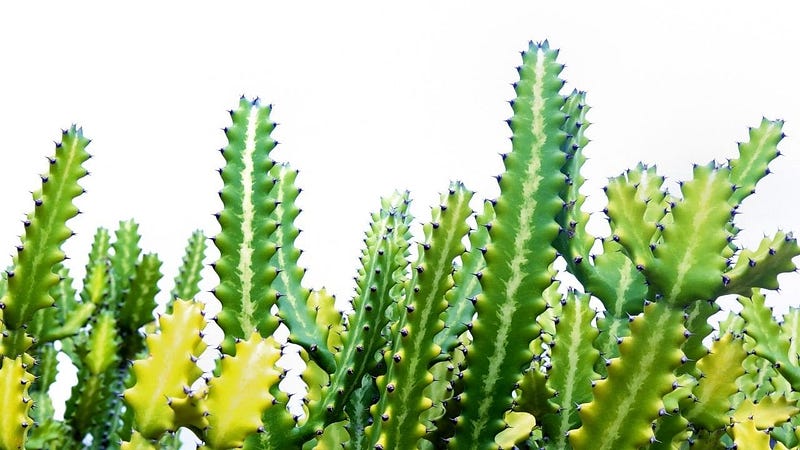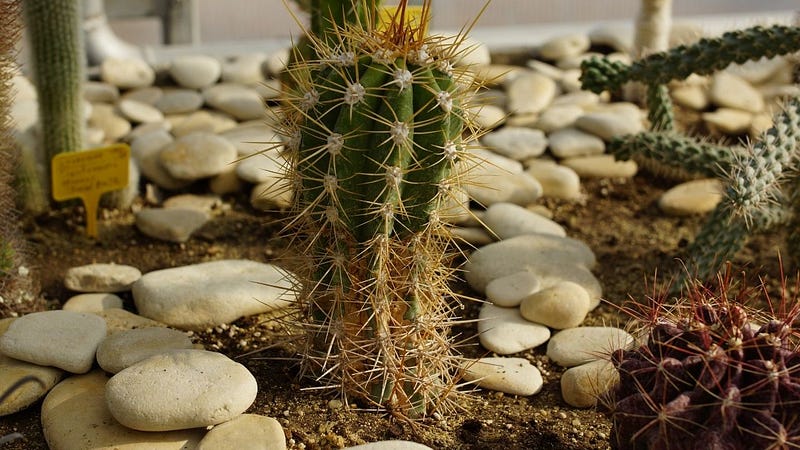Cactus flowers (type of succulents) are quite prominent in the field of landscape design. In particular, their berries, as well as buds, are used in drinks, salads, and sometimes even jellies. Cactus plants may simply be combined with several other drought-tolerant plants, trees, shrubs, and decorative grasses to create a stunning and healthy garden.
It is generally acknowledged that cactus prefer arid conditions and do not require a lot of water. However, just because you’re caring for a cactus doesn’t guarantee you won’t run into issues.
You may have observed that your cactus has gradually begun to appear yellow or brown. This could occur due to numerous factors. It is obviously not typical, and you’ll want to figure out what’s happening so that you could rectify any cactus problems. In order to care for Cactus Turning Brown along with Cactus Brown Spots, watch out for the soil condition first. Whether it's too wet or too dry, and also it may have root rot, Sunburn, Indoor stress from repotting, disease etc. Also, It's important if the soil nutritions are not adequate like proper nitrogen, calcium to make soil rich.
Throughout this article, we’ll go over all of the probable causes for your cactus becoming brown as well as what you could do to rescue it. Continue reading to learn all you need to understand.
Top 7 Reasons For Cactus Turning Brown And Shivering
Cacti brown spots happen for a variety of causes, as we indicated in the beginning. In this part, we’ll go through some of the most common reasons for this issue.

Cactus Turning Brown Tips
The issue might be root rot when the root of the cactus plant is getting brown and the stem is mushy and yellowish, resulting in a dying rotting cactus.
- Nevertheless, root rot can be difficult to rescue since the rot generally begins on the inside and spreads outward. In most situations, root rot indications will appear only after the disease has progressed.
- Cease watering the shrub as soon as you see indications of root rot or even transplant it in a well-draining medium.
- You could also attempt to retrieve your plant by clipping off all of the rotted tissue as well as part of the good tissue around it to prevent the rot from spreading.
- Remember to utilize a rinse, sharpened blade, and sanitize it after cuts using alcohol. When you’re finished, put sulfur granules into the incisions to aid the plant’s healing. Root rot is commonly caused by overwatering and soils with inadequate water runoff.
2. Indoor hazards
Cacti grown indoors are nevertheless susceptible to the same pests and illnesses as those grown outside. Houseplants, on the other hand, may have extra issues that are specific to them.
- Ensure that your potted shrubs aren’t too adjacent to a heat vent if they begin to brown or wilt out.
- Not with standing the dense coating of wax that covers the plant, the intense flow of air exiting the vent could induce plant tissues to dry up. AC vents can potentially cause comparable harm, however, the effects may take longer to manifest.
- When your cactus begins to brown and seem crumbly on one part but isn’t precisely near a window, it’s advisable to consider transferring it to a different location.
Cactus Sunburn seems to be the main prevalent and likely reason for your cactus plant becoming brown from the tip. It might seem unusual since most of us consider cacti as desert flowers that thrive in the light.
- Hardly all cactus varieties, however, survive in the heat like Paddle Cactus, Prickly Pear, Opuntia Cactus. To thrive, few among them require only a small amount of light plus partial shade.
- When you don’t make the effort to gradually expose cacti plants purchased from a garden center or store to the strong, outside light, they may get sunburned.
- Minor sunburn usually appears as a white discoloration upon the plant’s sun-facing part. The pale patches eventually develop into brown blotches, which are a sign of intense sunburn. Extensive brown sunburn on cacti plants is irreversible, and there is hardly anything you can do regarding it.
- If your plant has white patches, however, it can be saved by relocating it to a shaded location. It will totally recover if you give shade on the warmest days of the season. It would also assist if you spend little effort learning about your plant’s sunlight needs so that you can offer the greatest possible circumstances.
- Certain cactus ought not to be left indirect light from the sun the whole day. Remember that cactus varieties that aren’t accustomed to staying in full sun should be adapted by introducing them to direct sunlight for a brief amount of time per day.
- Over the course of a few weeks, gradually increase the exposure. It won’t take time for your plants to adjust to the new light situation outside.
- It’s also worth noting that some cacti shouldn’t be exposed to direct sunshine all day, they might end up as dried cacti.
- Scales are tiny bugs that, because of their rigid brown exterior coatings, look like brown dry patches on cactus plants. These bugs eat plant fluids, weakening the cactus plant and turning it yellow or brownish in the process.
- If this is the situation with your flower, try washing it using a weak liquid soap solution or dousing it with a flow of water to remove the scales. For big infestations, you could apply your favourite pesticide brand.
- Scales can also be killed by utilizing cotton swabs dipped in gardening oil on both sides. This causes an oil coating to develop on the upper end of the scales, shutting off the insects’ oxygen flow. The insects eventually die from suffocation.
5. Frost damage
- Frost damage could induce cactus tips to become brown in exposed places, similar to sunburns. The impact is quite comparable, and the only method to tell the difference between sunburn and frost damage would be to take a temperature reading.
- The membranes of a cactus plant rupture whenever they are exposed to cold conditions. The plant might try to self-heal by growing calluses around the injured cells, even if you don’t detect it immediately away.
- Even though the brittle patches on the shrub are typically spotty, it is the same sort of self-healing process that emerges after a thunderstorm.
- Interior plants which come into direct touch with the window panes might still be damaged by frost.
- It might be an indication of mite contamination if your cactus top is becoming brown in which new growth is developing.
- Red spider mites are small bugs that drain the fluids from the most delicate portions of your plant. Since these bugs are so tiny, it may be simpler to find their webs rather than the bugs themselves.
- Mite infestations are identified by rusty brown patches on the plant’s tip as well as the occurrence of mite webs.
- These bugs can destroy your plant when left unchecked since they munch on the outermost layer of the membrane. Red spider mites are particularly common among indoor cactus.
- Plants can sometimes arrive from the plantation already afflicted with these insects. Attempt spraying your shrub from above with a reasonably vigorous flow of water in order to remove the insects.
- Another sort of mite that can populate your cactus is root lice. Especially plants cultivated in conservatories, root lice could travel from container to container, rendering monitoring challenging.
- The best strategy to avoid root lice is to keep your fresh plants separate from the others for several days. To keep root lice at bay, you must limit soil pooling and reprocessing.
- Corking can be identified by the rapid emergence of solid bark like or brown membrane a few centimetres well above the soil of a rather normal cactus shrub.
- Apparently, this is a normal aspect of cacti plant ageing and shouldn’t be a cause for concern.
- Cactus Corking usually begins at the plant’s roots and progresses upwards. Since corking is a natural occurrence, there is hardly anything anyone can do to prevent your plant from browning.
How Do You Fix Brown Cactus- [7] Working Methods
Cactus Turning Brown and Yellow Tips
1. Fix root rot in Cactus
- Symptoms of cactus root rot include browning, shakiness, and spongy root systems. Your cactus might also become brown or black, which is a sign.
- Follow the appropriate steps right away if you suspect your plant has root rot.
- Extract your plant off its container and inspect the roots for damage. When a few of the cactus’ roots are still white, use a clean knife to cut off the darker, muddy roots and any rotting regions at the bottom.
- Leave the plant to air out and recover before transplanting it in a new pot with new cactus gardening material.
2. Watch Your Watering
- Amongst the most efficient strategies to rescue a dying cactus is to hydrate it properly.
- Excessive water, like a lack of it, is particularly harmful. Whenever it pertains to cactus, though, it’s preferable to tread on the side of caution.
- Furthermore, whilst the cactus plant is blooming, it is critical to hydrate well while keeping the following in mind:
3. Under-watering your cactus
Your cactus scrunches or droops if you don’t water it often enough, and it can even discolor, often changing to brown and dry. Offer them a good, vigorous watering to help them out.
4. Over-watering your cactus
- Assist the cactus to lose quite enough water as fast as feasible if over-watering is an issue.
- Choose an earthen clay container that is only somewhat larger than the cactus then load it using a readymade cactus mixture.
- To avoid upsetting the cactus’ fragile roots, carefully place it in the blend. The porous cactus mix lets water flow fast and thoroughly, whilst the clay container will drain out extra water from the root system.
5. Change the potting soil
What does any of this have to do with switching out the gardening soil?
The Easy answer is this-
- The first explanation is that the microbe which triggered the rot in the first place is most likely still alive in the existing soil.
- The next explanation and most significant, explanation is that some potting mediums are considered to be dense and likely store excess water.
- As a result, you’ll need to switch to a thinner, more permeable growing medium.
6. Feed them well
- Poor nutrition is to blame for the majority of plant issues, even a withering cactus.
- As a result, it’s necessary to feed your cactus in the best acceptable amount and frequency using a good cati fertilizer.
- Give a full cactus fertilizer every two weeks from May through early October.
- Nourish the cactus once a month throughout the fall as well as wintertime.
Why Is My Cactus Turning Yellow?
To begin with, there might be several reasons for yellow cactus plants. Sunburn is by far the most prevalent and likely cause of a cactus becoming yellow from the tip.
It’s typically more dangerous if the cactus turns yellow from the bottom rather than the top. The most typical cause is excessive moisture, which can lead to root rot. Insect contamination is a less prevalent cause of yellow cactus flowers.
Why Is My Cactus Turning Black?
Fungal infections such as bacterial necrosis, apex rot, as well as phyllosticta pad patches cause a cactus to turn black.
To rescue your interior plant at this phase, remove the infected portions and attempt to prevent illness from spreading to the remainder of your cactus along with other potted plants around.
Read more on how to review and care for cactus turning yellow.




























